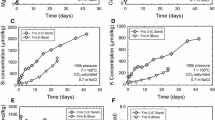Abstract
Despite substantial scientific research efforts, accurate determination of the petrophysical effects of clay minerals on reservoir sands remains problematic. Diagenetic clays such as smectite and illite are of particular interest because of the pronounced effects these clays can have on reservoir quality. Here, results are reported from an experimental study based on the hydrothermal growth of smectite in synthetic sands. The sands contained quartz, dolomite and kaolinite, and were reacted at 175–200°C, for 19–45 d. The hydrothermal reaction can be written as follows:
X-ray diffraction (XRD), electron microprobe (EMP) and electron diffraction (ED) analysis show that the synthetic Mg-rich smectite formed is saponite, with a cation exchange capacity (CEC) of about 100 meq/100 g. After reaction, brine permeability reductions of up to 98% were observed from the growth of less than 5% smectite. Scanning electron microscopy (SEM) observations of critical-point-dried reacted samples show that the clay behaves as a pervasive microporous cement with a complex pore-bridging texture affecting most of the available pore space. Morphologically, the clay is similar to naturally occurring diagenetic smectite from Gulf Coast sandstone reservoirs. The delicate clay texture collapses during air-drying and forms pore-lining masses. This phenomenon is similar to that observed for air-dried reservoir samples which contain dispersed diagenetic clays. An air-dried sample, then resaturated with brine, showed a marked increase in permeability. This increase is associated with the irreversible collapse of the clay texture. The experimental results indicate that the growth of diagenetic clay can severely reduce formation permeability, even at very low clay contents. The results also demonstrate the utility of hydrothermal experimental petrophysics for investigating the effects of diagenesis on rock properties.
Similar content being viewed by others
References
Bain DC, Smith BS. 1987. Chemical analysis. In: Wilson MJ, editor. A handbook of determinative methods in clay mineralogy. London: Blackie. p 248–274.
Beard DC, Weyl PK. 1973. Influence of texture on porosity and permeability of unconsolidated sand. Am Assoc Petrol Geol Bull 57:349–369.
Bjørkum PA, Gjelsvik N. 1988. An isochemical model for the formation of authigenic kaolinite, K-feldspar, and illite in sediments. J Sed Petrol 58:506–511.
Bjørkum PA, Nadeau PH. 1996. A kinetically controlled fluid pressure and migration model. Am Assoc Petrol Geol Ann Conv Proc Abstr. p A15.
Bjørlykke K. 1983. Diagenetic reactions in sandstones. In: Parker A, Sellwood W, editors. Sediment diagenesis. Dordrecht: Reidel. p 169–213.
Burst JF. 1969. Diagenesis of Gulf Coast clayey sediments and its possible relation to petroleum migration. Am Assoc Petrol Geol Bull 53:73–93.
Bushell TP. 1986. Reservoir geology of the Morecambe Field. In: Brooks J, Goff J, van Hoorne B, editors. Habitat of Paleozoic gas in N. W. Europe. Geol Soc Spec Publ 23. p 189–208.
deWaal JA, Bil KJ, Kantorowicz JD, Dicker AIM. 1988. Petrophysical core analysis of sandstones containing delicate illite. The Log Analyst 29:317–331.
Ehrenberg SN. 1993. Preservation of anomalously high porosity in deeply buried sandstones by grain-coating chlorite: Examples from the Norwegian Continental Shelf. Am Assoc Petrol Geol Bull 77:1260–1286.
Ehrenberg SN, Nadeau PH. 1989. Formation of diagenetic illite in sandstones of the Gam Formation, Haltenbabken area, Mid-Norwegian Continental Shelf. Clay Miner 24: 233–253.
Ellis DV. 1987. Well logging for earth scientists. New York: Elsevier. 532 p.
Harrison WJ, Summa LL. 1991. Paleohydrology of the Gulf of Mexico Basin. Am J Sci 291:109–176.
Heaviside J, Langley GO, Pallatt N. 1983. Permeability characteristics of Magnus reservoir rock: Paper A. London; 8th European Formation Evaluation Symp. p 1–29.
Hermanrud C. 1993. Basin modelling techniques—An overview. In: Doré AG, Auguston JH, Hermanrudd C, Stewart DJ, Sylta O, editors. Basin modelling advances and applications. Norwegian Petroleum Soc Spec Publ 3. Amsterdam: Elsevier, p 1–34.
Hurst A, Irwin H. 1982. Geological modeling of clay diagenesis in sandstones. Clay Miner 17:5–22.
Hurst A, Nadeau PH. 1995. Clay microporosity in reservoir sandstones: An application of quantitative electron microscopy in petrophysical evaluation. Am Assoc Petrol Geol Bull 79:563–573.
Hutcheon I, 1984. A review of artificial diagenesis during thermally enhanced recovery. In: McDonald DA, Surdam RC, editors. Clastic diagenesis. Am Assoc Petrol Geol. Memoir 37. Tulsa, p 413–429.
Kirk JS, Bird GW, Longstaffe FG. 1987. Laboratory study of the effects of steam-condensate flooding in the Clearwater Formation: High temperature flow experiments. Can Soc Petrol Geol 35:34–47.
McHardy WJ, Birnie AC. 1987. Scanning electron microscopy. In: Wilson MJ, editor. A handbook of determinative methods in clay mineralogy. London: Blackie. p 174–208.
McHardy WJ, Wilson MJ, Tait JM. 1982. Electron microscope and X-ray diffraction studies of filamentous illitic clay from sandstones of the Magnus Field. Clay Miner 7: 23–29.
Nadeau PH, Hurst A. 1991. Application of back-scattered electron microscopy to the quantification of clay mineral microporosity in sandstones. J Sed Petrol 61:921–925.
Pallatt N, Wilson MJ, McHardy WJ. 1984. The relationship between permeability and the morphology of diagenetic il-lite in reservoir rocks. J Petrol Technol 36:2225–2227.
Waxman MH, Smits LJM. 1968. Electrical conductivities in oil-bearing shaly sands. Soc Petrol Eng J 243:107–122.
Wilson MD, Pittman ED. 1977. Authigenic clays in sandstones: Recognition and influence on reservoir properties and paleo-environmental analysis. J Sed Petrol 47:3–31.
Author information
Authors and Affiliations
Rights and permissions
About this article
Cite this article
Nadeau, P.H. An Experimental Study of the Effects of Diagenetic Clay Minerals on Reservoir Sands. Clays Clay Miner. 46, 18–26 (1998). https://doi.org/10.1346/CCMN.1998.0460103
Received:
Accepted:
Published:
Issue Date:
DOI: https://doi.org/10.1346/CCMN.1998.0460103




